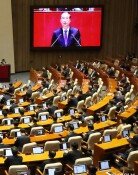Glut Spurs Gov`t to Donate Rice to E. Asia
Glut Spurs Gov`t to Donate Rice to E. Asia
Posted September. 25, 2009 07:34,
The government yesterday said it will send around 100,000 tons of rice aid to East Asian nations from next year at the earliest.
Of 720,000 tons of accumulated rice, the government will provide around 100,000 tons to East Asian nations to raise their rice reserves for emergencies. It will be Koreas largest food aid package in history, a government source said.
The food aid proposal will be announced at a meeting of agriculture ministers of the Association of Southeast Asian Nations plus South Korea, China, and Japan slated for next month or November.
Under an agreement reached in 2002, the associations 10 member nations -- the Philippines, Thailand, Indonesia, Vietnam, Malaysia, Myanmar, Cambodia, Brunei, Taiwan and Laos -- and South Korea, China and Japan will cooperate to raise rice reserves and sell, lend or distribute rice free in case of emergency like a food shortage.
Given that South Korea, China and Japan have abundant rice, the plan is apparently intended to support developing nations. Beijing will donate 300,000 tons of rice and Tokyo 250,000 tons, but Seoul has yet to announce how much rice it will provide.
The food aid project is also seen as a way to reduce the oversupply of rice. Park Dong-gyu, senior researcher at Korea Rural Economic Institute, said, Providing rice to developing nations can be a good way to handle a surge in rice supply and improve national image.
Domestic farmers have enjoyed abundant harvests for several years, so the price of rice has continuously fallen in rice-producing areas. Last year saw a record crop of 4.84 million tons, worsening the surplus.
As of Sept. 15, rice produced last year went for 146,900 won (123.34 U.S. dollars), falling around 20,000 won (16.79 dollars) from Sept. 15 last year, when rice produced in 2007 was traded at 161,700 won (135.77 dollars). Domestic farmers are also likely to produce more than 4.6 million tons of rice this year.
Under an agreement with the World Trade Organization, South Korea has a rice import quota since its rice market is not open to the global market. The mandatory amount of rice to be imported this year is 307,000 tons, up around 80,000 tons from 2005. Rice reserves have also jumped from 690,000 tons last year to 816,000 tons this year.
To boost rice consumption, the government plans to encourage the production of noodles and rice wine and cut the price of rice used in product processing such as rice wine, snacks and sliced rice cake around 34 percent from 1,446 won (1.21 dollars) to 950 won (80 cents) per kilogram from Sept. 28. At the same time, more rice will go to military units and schools.
Others say rice aid to North Korea should resume, saying South Koreas glut of rice is due to Seouls decision to stop food aid to Pyongyang. The South had provided 2.65 million tons of rice to the North since 1995, but stopped shipments last year.
With the harvest season coming, farmers are urging measures to handle plummeting rice prices. Farmers associations have held gatherings nationwide to say the government should reduce rice inventory by sending part of it to North Korea.
achim@donga.com zeitung@donga.com







